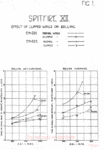You used Km/h instead of m/s. That gives you the wrong result.
No it doesn't Hop, what we were looking for was the difference between both a/c and as you can see the difference is the same wether you use km/h or m/s.
Um, you can turn at different rates. You can most certainly turn at a CL of 0.5, if that provides more lift than you need for level flight.
Listen if Clmax is 1.36 then you're not really turning very well at 0.5 now are you ??
What we want to be looking at is CLmax, as this is the region both a/c are most likely going to reach when they turn fight each other.
Um, do you understand physics at all? If lift exceeds weight, the plane is going to be moving in the direction of lift.
Yes I do understand physics, however you're having big trouble indeed Hop. Ever wondered why a/c need to adjust pitch settings as speed goes up ?? Or are you under the impression that as speed increases lift stayes the same ??
Keep it coming Hop!
No. If you are generating more lift/weight, you are pulling more G. Go and look up the concept of bank angle and G.
For Christ's sake what is it you don't understand man ?!!
Yes like I said a higher L/W ratio gives you a higher INITIAL turn rate, however since the Spitfire has got loads more drag pr. lift its going to loose out quickly in a sustained turn fight.
In other words, you are guessing. You don't have Oswald efficiency figures for either aircraft, just rough figures for similar wing shapes.
Rough figures ?? No, exact figures Hop. But yes there is a little guesswork involved as we don't have the 'e' figure for both aircraft, however knowing the difference in 'e' of a completely elliptical with no twist and an AR of 6, and also knowing what approximate effect leading edge guns have on 'e' I can make a reasonable and educated guess.
The percentage difference is there, but absolute figures are not.
Like I said, we're calculating the difference between two a/c here, so therefore it doesn't matter wether its in km/h or m/s, the difference in percentages is the same.
International standard atmosphere density is 1.225 at sea level. It's not worth arguing over, though, as your figure isn't "wrong", just non-standard.
There can be many reasons why the international std. is different, but again wether we use the international std. figure or the other more regional one doesn't matter, the difference stayes the same.


